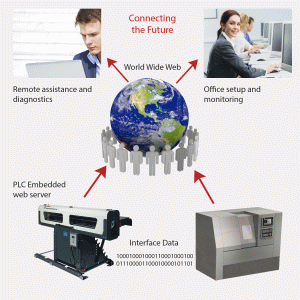Click here to download the "Bar Feed - Turning Machine eConnect Communications System Reduces Material Waste While Increasing Productivity" White Paper
The machine operator could reprogram the lathe and bar feed to make a different part from the remaining material, but this would interrupt your schedule, and the operator time involved would be counterproductive. Wouldn’t it be great if the turning machine and barfeed could figure out how to make a good part out of that costly piece of metal without requiring additional operator time?
Well, now they can.
Barfeed maker LNS has developed a proprietary database and data transfer system that enables a turning machine and an LNS barfeed to share real-time information. This capability means that, among other things, the barfeed and turning machine can analyze material usage, and then the turning machine can search your production schedule, find another part that can be made from the remaining material, and change a part program on the fly. So whether you’re using an expensive alloy or more conventional bar stock, you can now reduce material waste and labor costs while making your production process more efficient.
Connects Part Programs & Production Schedule
Developed in cooperation with major turning machine Original Equipment Manufacturers (OEMs) and with extensive input from end users, the system enables manufacturers to create a library of over one thousand parts programs that are stored in the barfeed’s Programmable Logic Controller (PLC). Each part program in the library has a unique identifying number, and  contains all of the production parameters required by the barfeed for that specific part. Using these part programs, the manufacturer can develop a production schedule as simple or complex as desired. Because the system allows for a great deal of flexibility, users can design the production schedule to maximize efficiencies in virtually all applications.
contains all of the production parameters required by the barfeed for that specific part. Using these part programs, the manufacturer can develop a production schedule as simple or complex as desired. Because the system allows for a great deal of flexibility, users can design the production schedule to maximize efficiencies in virtually all applications.
Once the operator initiates production under this schedule, the barfeed continuously tracks material usage, informing the turning machine about how much stock is available. Using our earlier example, let’s say the turning machine recognizes that the 4” of material remaining is not sufficient to produce one more of the part it has been running, we’ll call it part # 123. The turning machine, now aware of how much material remains, scans the parts scheduler to determine if there is another part in the queue that can be made from this 4” piece of bar stock. According to the scheduler, part # 678 is a viable match. Now the turning machine sends the part number to the barfeed, which scans the parts library to locate a match. Finding one, the barfeed downloads the parameters for part # 678 and makes these the current settings by automatically adjusting such factors as part length and top cut position. All of these adjustments are performed automatically on select LNS barfeed models. As a result, the machine tool can move seamlessly from one job to another without operator assistance.
In this case, the turning machine makes part # 678, thus using the 4” of remaining bar stock that otherwise may have become scrap. Now the turning machine will check the schedule to determine whether to continue making the original part (#123 in our example), or move on to another part program. All of these communications between the barfeed, the turning machine, the production scheduler and the parts library are virtually instantaneous and require no operator assistance. Provided parts use the same bar stock shape and diameter, the scheduler is capable of efficiently completing an infinite mix of long or short production runs, a complex family of parts and even a variety of unrelated parts. Clearly, these capabilities contribute a substantial savings of time, labor and material.
Recognizes Priorities
The system design takes into account that some production schedulers may wish to develop more complex agendas, including such advanced functions as prioritizing part programs. In such a case, if the turning center’s production scheduling program contains more than one part that can be made from remaining material, the scheduler selects the appropriate part program based on the variables built into the schedule. Typically, the scheduler assigns priorities to like size parts, based on needs. The scheduler will follow these directives and download the part program with the highest priority from the library, based on the remaining bar stock length. Because the scheduler can also track how many of each part is made, it knows whether or not there is still a need for the first priority part. If not, the scheduler will bypass that part and move on to the next highest priority. It will continue working through the schedule in this way until it finds the next available part.
Advanced Ethernet Connectivity
With Ethernet connectivity, the cost-saving possibilities are even more impressive. For example the barfeed can use an Ethernet connection to establish remote communications. With the push of a button you can email the parts library to any designated email account. This means the parts programmer, production manager or any other individual within the company granted permission, can remotely analyze the parts library and make changes. Need to add or delete a program from your office in another part of the building? How about from a facility in another town? Or in another country? As long as you have Internet access, it’s no problem.
Another advantage is that if a barfeed alarm occurs, the system can automatically email the fault notification to one or several designated email accounts for real-time analysis and support. Compare this to communicating over the phone or via Fax which can lead to misunderstandings, transposing numbers and other errors that impede progress. Emailing precise information to offsite experts may reduce machine downtime and save travel time and expense. These data can provide the LNS support team a clear picture of the current situation, which may allow them to troubleshoot and suggest remedies on the spot. Plus, if it becomes necessary to send a service technician to your site, this information allows them to be better prepared. Equally important, email notification means you, your operator or production supervisor will know instantly when someone needs to check the production line. This can be especially valuable when running unattended.
More To Come
Currently in use with select turning machines, the system will soon be more widely available. LNS continues to listen to OEMs and end users, and their needs will drive the development of other useful enhancements.
This unique electronic connection system helps reduce downtime, material waste and labor costs, all of which help manufacturers maximize productivity and profitability.

